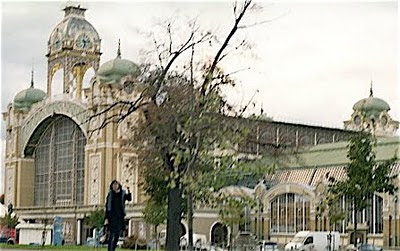
When we stumbled across it, quite by accident, it could hardly have looked more different than than the merrily populated exhibition concourse captured in the above postcard. The whole area, on the south-east edge of Stromovka Park, seemed haunted in a way that completely escaped our own photos as much as the official portraits from over a century ago. Everything suffused with the greyness of the sky, everything slightly overgrown. The fact that, dotted amongst the trees and the domes, and the weird futurist pods, were still-functioning amusements, dodgems and shooting galleries, their lonely operators hopelessly desperate for the scattered trade of the lost, made it all the more eerie, evoking Herk Harvey's (1962) uncanny chiller, Carnival of Souls. What is perhaps most extraordinary is that, unlike its architectural cousin the Crystal Palace, and so many of the other great iron and glass exhibition halls of the nineteenth century (see this great post by Douglas Murphy), the palace of industry, leftover from the 1891 Prague Jubilee Exhibition, still stands, weather-beaten, decaying somewhat, but erect and in one piece.
The ghosts of Expos past are scattered all over Prague. From 1891, stands the Hanavský Pavillion in Letna Park. A stones throw from Vratislav Novak's great metronome, a monument to the passing of time, that replaced a fifty metre high marble of statue of Stalin that once towered over the city. The Petrin Tower, also built in 1891, a younger sister to Eiffel's tower which it mimics, since an expedition of Czechs were inspired by a visit to the Exposition Universelle in 1889.
Boycotted at the time by Prague's then-significant German population, the 1891 Expo was a proud declaration of nationhood on the part of a state-to-come, haunted by its own consumption within the Austro-Hungarian Empire and a messianic desire for independence. As such, the event should be seen in the context of two other almost-simultaneous expressions of Czech nationhood: the building of the National Theatre, funded by collections from the mass of the people who apparently wanted a decent venue in which to watch the operas of Smetana; and the formation of the Mánes Union of Fine Arts, a secessionist avant-garde art group, that would later include Josef Čapek, who coined the word 'Robot'.
In the enormous, functionalist Trade Fair Palace, home to the national modern and contemporary art collection, there is a room dedicated to the galvanising effect on art and design of Czechoslovakian success at the Brussels Expo in '58. The restaurant which once adjoined the Czech Pavilion at Brussels has been preserved, also in Letna Park, albeit sold off as office space to an advertising agency, like so many other ghosts from the great exhibitions.



